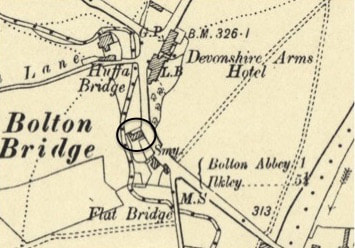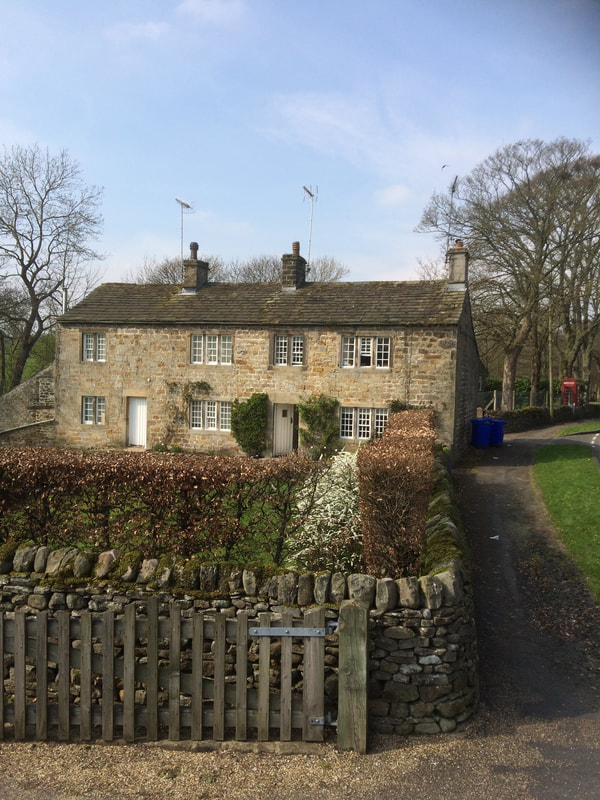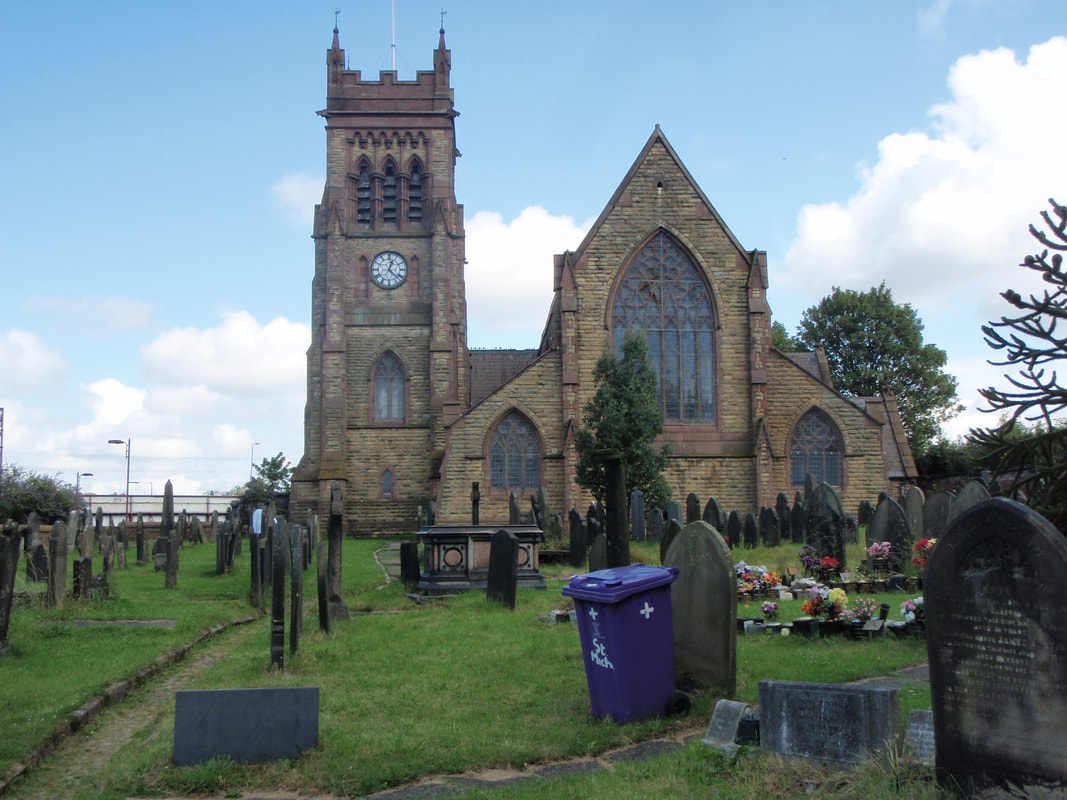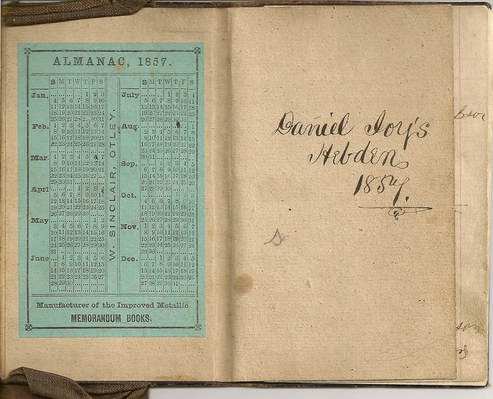 Daniel Joy's Memorandum Book - 1857 © Dave Joy 2017
Daniel Joy's Memorandum Book - 1857 © Dave Joy 2017
In researching my family history, records of Daniel Joy’s birth have eluded me. Fortunately, Daniel kept a small memorandum book in which he made a note of key events and significant dates in the lives of his family members. The book was printed in 1857 and was manufactured by W. Sinclair of Otley. In it, Daniel has noted the dates of birth of his siblings and that of himself – he was born on 11th May 1825.
Daniel first appears in official records during the 1851 census. He is a 25-year-old farm labourer working for Jeremiah Stockdale at Langerton, in the village of Thorpe. Then, on 15th August 1859, he married Mary Lowcock (1834-1872) at Skipton Register Office. Witnesses to the ceremony were Daniel’s sister, Hannah Joy, and Mary’s sister, Maria Petty. At that time Daniel’s father worked as a farmer and also as an innkeeper at the Clarendon Inn, Hebden, whereas Mary’s father was the landlord of the Castle Inn, Skipton.
There are two relevant entries in the 1861 census. The first shows Daniel as an absent head of household living with Mary in the village of Halton East – they have a two-year-old daughter, Sarah. The second records Daniel working in nearby Bolton Bridge as a ‘Herdsman’ at the Devonshire Arms, the household of William Bayley Wilson. An inn such as the Devonshire Arms would have had a farm large enough to supply a robust menu for its many patrons and it was Daniel’s job to look after the stock.
Daniel first appears in official records during the 1851 census. He is a 25-year-old farm labourer working for Jeremiah Stockdale at Langerton, in the village of Thorpe. Then, on 15th August 1859, he married Mary Lowcock (1834-1872) at Skipton Register Office. Witnesses to the ceremony were Daniel’s sister, Hannah Joy, and Mary’s sister, Maria Petty. At that time Daniel’s father worked as a farmer and also as an innkeeper at the Clarendon Inn, Hebden, whereas Mary’s father was the landlord of the Castle Inn, Skipton.
There are two relevant entries in the 1861 census. The first shows Daniel as an absent head of household living with Mary in the village of Halton East – they have a two-year-old daughter, Sarah. The second records Daniel working in nearby Bolton Bridge as a ‘Herdsman’ at the Devonshire Arms, the household of William Bayley Wilson. An inn such as the Devonshire Arms would have had a farm large enough to supply a robust menu for its many patrons and it was Daniel’s job to look after the stock.
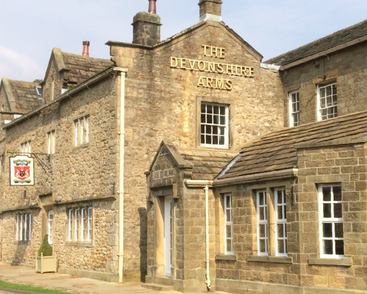 The Devonshire Arms Hotel, Bolton Abbey, Bolton Bridge, Wharfedale. © Dave Joy 2017
The Devonshire Arms Hotel, Bolton Abbey, Bolton Bridge, Wharfedale. © Dave Joy 2017
The Devonshire Arms was something of a prestigious establishment in which to be working. Built in the early 17th century, it came into the ownership of the 4th Duke of Devonshire in 1753 as part of the Bolton Abbey Estate. The 5th Duke realised the importance of tourism and carried out further developments ensuring many miles of footpaths were established to access the splendid views. During the 19th century the Royal Family would stay at Bolton Abbey for grouse shoots. Consequently, the Devonshire Arms, which was frequented by Royal parties, expanded, so that by 1840 it could stable twenty horses and four carriages.
The Register of Baptisms at Bolton Abbey gives the birthplace of Daniel and Mary’s first two children as Halton (Sarah b. 1859 and Elizabeth b. 1862). However, by the time of the baptism of their third child, Anthony (b. 1863), they were living in Bolton Bridge. Presumably, this relocation was so that Daniel could be closer to his place of work.
The Register of Baptisms at Bolton Abbey gives the birthplace of Daniel and Mary’s first two children as Halton (Sarah b. 1859 and Elizabeth b. 1862). However, by the time of the baptism of their third child, Anthony (b. 1863), they were living in Bolton Bridge. Presumably, this relocation was so that Daniel could be closer to his place of work.
Anthony was to be Daniel and Mary’s only son, and by 1868 he had five sisters. All six siblings were baptized at The Priory Church of St Mary & St Cuthbert, Bolton Abbey. In his memorandum book, Daniel recorded the names of the godparents of each of his first six children; presumably, these were friends and family members, who would have been in attendance at the various baptisms.
It seems that life had been good for Daniel and Mary up until that point. However, the family was soon to be struck by tragedy. Their eldest child, Sarah, developed Scarlatina. Although not as rampant as it had once been, by the 1860s the disease was still contagious and was still capable of taking the life of a child. It is likely that Sarah was kept away from her siblings during her illness. She struggled with the disease for three weeks before finally succumbing on 23rd June 1868, aged eight years and eight months. The family’s grief at the loss of their eldest daughter is conveyed in the following verse that was printed on her funeral card:
Our beautiful and lovely child,
In whom we took delight.
No more her well known voice we hear,
To bid us all good night.
Her little bark was very soon
O’er life’s wild ocean driven;
The first rough stormy wind that blew,
It wafted her to heaven.
In whom we took delight.
No more her well known voice we hear,
To bid us all good night.
Her little bark was very soon
O’er life’s wild ocean driven;
The first rough stormy wind that blew,
It wafted her to heaven.
While she had been nursing her daughter, Mary was in the final stages of her sixth pregnancy. And it was just five days after losing Sarah that Mary gave birth to Jane, born on 28th June. Sadly, Jane was not a well baby and did not survive beyond her first month. She died on July 23rd 1868 after suffering from ‘convulsions’. The Joy sisters were both buried at Priory Church, Bolton Abbey, Sarah on 10th July and Jane on 25th July. The family’s grief would have been compounded, just a month later, when they received news regarding the death of Daniel’s sister, Hannah Stockdale, and then, a further three weeks later, regarding that of his father, Thomas Joy.
The loss of two daughters in this way must have been gravely felt and it is not surprising that when, on 18th August 1869, the birth of their seventh child produced another daughter, she was christened Sarah Maria, after their eldest daughter, Sarah. Daniel noted in his memorandum book the date and time of Sarah Maria’s birth - Wednesday morning, 7 o’clock.
The loss of two daughters in this way must have been gravely felt and it is not surprising that when, on 18th August 1869, the birth of their seventh child produced another daughter, she was christened Sarah Maria, after their eldest daughter, Sarah. Daniel noted in his memorandum book the date and time of Sarah Maria’s birth - Wednesday morning, 7 o’clock.
This newly constituted household is recorded in the census of 1871. Daniel (age 45, an ‘Agricultural Labourer’) is living with his wife, Mary (age 36), and his children: Elizabeth (age 9), Anthony (age 7), Hannah (age 6), Mary (age 4) and Sarah Maria (age 1). They also had two lodgers living with them, Stephen Croft and Emma Moorhouse. The only address given in the census is ‘Private house’, but it appears to be located between Bolton Bridge Toll House and the Devonshire Arms. Working from old maps of the area I believe I have obtained the location of the house in question and it is still standing today adjacent to what is now the Abbey Tea Rooms, Bolton Bridge.
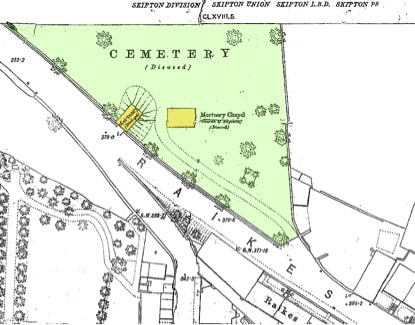 Location of Raikes Road Burial Ground, Skipton.© FRRBG 2017
Location of Raikes Road Burial Ground, Skipton.© FRRBG 2017
The 1871 census took place on 2nd April. However, by the November of that year Daniel and Mary, along with their young family, had left their home in Bolton Bridge and were living in the Millfields district of Skipton. Perhaps the reason for this move was that Daniel managed to secure employment at the Ship Brewery in Skipton, working as a Brewer’s Assistant. Another consideration may have been that Mary was pregnant again, so this would have been a move closer to her family.
The family’s eighth child, Abigail was born at the end of November 1871; she was possibly named after Mary’s sister (who married John Baxter). Sadly, she was diagnosed with Pneumonia Infantitis and only survived for two weeks. She died on 8th December 1871 and was buried at Raikes Road, Skipton. The burial ground at Raikes Road was open between 1846 and 1876, the last burials taking place in 1900. The site is now being researched and restored by the Friends of Raikes Road Burial Ground (http://frrbg.org.uk/).
It seems that this latest loss was one too many for Mary to bear, for she had apparently taken to drinking excessively. This situation not only ‘greatly marred domestic comfort’, but also, ultimately, led to further tragedy when, on December 4th 1872, Mary took her own life.
The family’s eighth child, Abigail was born at the end of November 1871; she was possibly named after Mary’s sister (who married John Baxter). Sadly, she was diagnosed with Pneumonia Infantitis and only survived for two weeks. She died on 8th December 1871 and was buried at Raikes Road, Skipton. The burial ground at Raikes Road was open between 1846 and 1876, the last burials taking place in 1900. The site is now being researched and restored by the Friends of Raikes Road Burial Ground (http://frrbg.org.uk/).
It seems that this latest loss was one too many for Mary to bear, for she had apparently taken to drinking excessively. This situation not only ‘greatly marred domestic comfort’, but also, ultimately, led to further tragedy when, on December 4th 1872, Mary took her own life.
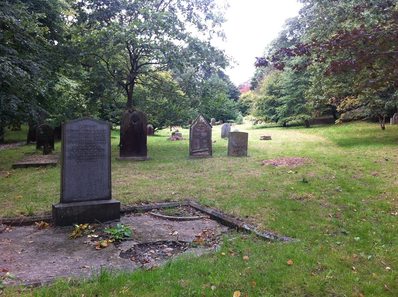 Raikes Road Burial Ground, Skipton. © Dave Joy 2017
Raikes Road Burial Ground, Skipton. © Dave Joy 2017
The inquest into Mary’s death was held the following morning before Mr T. P. Brown, Deputy Coroner, at the Commercial Inn, Millfields, Skipton. Friends of Raikes Road Burial Ground have kindly provided a transcript of the proceedings:
Mrs Daniel Joy was found drowned in the Spindle Mill dam and there is too much reason to fear that she had thrown herself into the water. The maiden name of the deceased was Mary Lowcock; she was a daughter of Mr Lowcock, formerly the landlord of the Castle Inn, Skipton. Several years ago she was married to a quiet respectable man, now an employee at the Ship Brewery, named Daniel Joy and the family includes five children.
Unhappily, Mrs Joy had acquired a strong passion for intoxicants and this has greatly marred domestic comfort. On Wednesday morning last, after her husband left home for work, she got up and went out about seven o’clock. About half past eight she was found dead in the dam, with a black handkerchief tied round her dress very tightly. The handkerchief had apparently been tied round the ankles, but the knot having slipped, or from some other cause, the handkerchief had removed to near the knees, where it was found when deceased was taken out of the water.
Daniel Joy said that about ten minutes past five o’clock on Wednesday morning, he left home. He had not had any quarrel with the deceased, who appeared to be as usual. He heard afterwards that she had been found in the water and saw a black handkerchief, which belonged to her, in the possession of the Police.
Anthony Joy said his mother called him up after the father went out. She afterwards got up herself and went out about seven o’clock saying she would be back directly. She had been in the habit of taking drink.
P.C. Tillotson said, shortly after eight o’clock on the morning named, he went to Mr Dinsdale’s dam and there found the deceased, who was got out by a boathook. The water was not more than two feet above the mud at the bottom.
The black handkerchief produced was tied round the deceased’s dress and was so short that no person could have fastened it without the consent of the deceased.
The jury returned a verdict to the effect that the deceased had drowned herself whilst in a fit of temporary insanity and after inspecting the dam, recommended that the public footpath at the side of the mill dam be stopped at both ends, as the path is of little use and is very dangerous.
The funeral card for Mary Joy states that she died on 4th December 1872 and was buried on 6th December 1872 - at Raikes Road Burial Ground, Skipton. As it was deemed that Mary had committed suicide, she would have been buried without the full rites of the church being performed and, consequently, her grave is unmarked.
Mrs Daniel Joy was found drowned in the Spindle Mill dam and there is too much reason to fear that she had thrown herself into the water. The maiden name of the deceased was Mary Lowcock; she was a daughter of Mr Lowcock, formerly the landlord of the Castle Inn, Skipton. Several years ago she was married to a quiet respectable man, now an employee at the Ship Brewery, named Daniel Joy and the family includes five children.
Unhappily, Mrs Joy had acquired a strong passion for intoxicants and this has greatly marred domestic comfort. On Wednesday morning last, after her husband left home for work, she got up and went out about seven o’clock. About half past eight she was found dead in the dam, with a black handkerchief tied round her dress very tightly. The handkerchief had apparently been tied round the ankles, but the knot having slipped, or from some other cause, the handkerchief had removed to near the knees, where it was found when deceased was taken out of the water.
Daniel Joy said that about ten minutes past five o’clock on Wednesday morning, he left home. He had not had any quarrel with the deceased, who appeared to be as usual. He heard afterwards that she had been found in the water and saw a black handkerchief, which belonged to her, in the possession of the Police.
Anthony Joy said his mother called him up after the father went out. She afterwards got up herself and went out about seven o’clock saying she would be back directly. She had been in the habit of taking drink.
P.C. Tillotson said, shortly after eight o’clock on the morning named, he went to Mr Dinsdale’s dam and there found the deceased, who was got out by a boathook. The water was not more than two feet above the mud at the bottom.
The black handkerchief produced was tied round the deceased’s dress and was so short that no person could have fastened it without the consent of the deceased.
The jury returned a verdict to the effect that the deceased had drowned herself whilst in a fit of temporary insanity and after inspecting the dam, recommended that the public footpath at the side of the mill dam be stopped at both ends, as the path is of little use and is very dangerous.
The funeral card for Mary Joy states that she died on 4th December 1872 and was buried on 6th December 1872 - at Raikes Road Burial Ground, Skipton. As it was deemed that Mary had committed suicide, she would have been buried without the full rites of the church being performed and, consequently, her grave is unmarked.
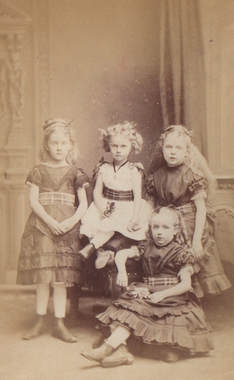 The daughters of Daniel Joy © David Joy 2017
The daughters of Daniel Joy © David Joy 2017
Daniel was now a widower with five young children. Under such circumstances it would have been natural to turn to his extended family for help. In that respect he had a number of local options: his sister Mary Ann had married Jeramiah Hardacre and was living in Bordley; his sister Elizabeth had married James Wadilove and was living in Hebden; and, his brother Thomas had married Mary Anne Brown and was living and working as a gamekeeper at Middleton Lodge, Ilkley.
But, Daniel also had family living further afield. Three other siblings, Hannah, Orlando and George, had all relocated to Liverpool in the early 1860s and, working together, had become cowkeepers, establishing a number of dairies in and around the city. Hannah had since married Thomas Stockdale and had returned to Wharfedale to live with Thomas at his family’s Rainlands Farm, Hebden. But, George and Orlando were still doing good business as cowkeepers and they were probably instrumental in persuading Daniel to pack up his belongings and relocate his family. He took over the running of one of his brothers’ dairies in Railway Street in the township of Garston – lying just to the south of the city of Liverpool.
But, Daniel also had family living further afield. Three other siblings, Hannah, Orlando and George, had all relocated to Liverpool in the early 1860s and, working together, had become cowkeepers, establishing a number of dairies in and around the city. Hannah had since married Thomas Stockdale and had returned to Wharfedale to live with Thomas at his family’s Rainlands Farm, Hebden. But, George and Orlando were still doing good business as cowkeepers and they were probably instrumental in persuading Daniel to pack up his belongings and relocate his family. He took over the running of one of his brothers’ dairies in Railway Street in the township of Garston – lying just to the south of the city of Liverpool.
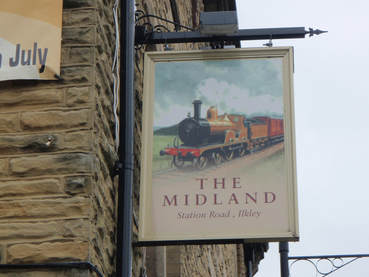 The Midland Hotel, Station Road, Ilkley. © Dave Joy 2017
The Midland Hotel, Station Road, Ilkley. © Dave Joy 2017
A few years after Daniel’s arrival, Orlando married a Wharfedale lass, Hannah Daggett, and returned to Yorkshire to become the landlord of The Midland Hotel in Ilkley. (He died in 1881 from sclerosis of the liver). But, both George and Daniel chose to remain in Liverpool, making a living as cowkeepers. Nevertheless, the ties with Wharfedale remained strong and there was much to-ing and fro-ing, either for pleasure or on business or dealing with family matters. Indeed, a year after his relocation to Garston, Daniel returned to Bolton Bridge to attend the family funeral of his former employer at The Devonshire Arms Hotel - Elizabeth, the wife of William Bayley Wilson, was interred at Bolton Abbey on 24th August 1874.
Daniel did not re-marry and he raised his five surviving children on his own. They all grew up living and working at the Railway Street dairy and some went on to have cowkeeping businesses of their own:
Daniel did not re-marry and he raised his five surviving children on his own. They all grew up living and working at the Railway Street dairy and some went on to have cowkeeping businesses of their own:
Elizabeth (1862-1945) - Married Thomas Caleb Stringfellow on 25th October 1884 at St. Michael in the Hamlet, Aigburth. Relocated to Crewe, Cheshire. Children: Henrietta (1887-1928), Henry (1887-1963) and Frederick Thomas (1889-1949).
Anthony (1863-1937) - Married Ann Jane Percival on 17th May 1888 at St Michael’s, Garston. He was a cowkeeper at 23 Island Road and then at 37 Wellington Street, Garston. Buried at St Michael’s, Garston. Children: Anthony Percival (1889- 1973), Ellen Gertrude (1891-1891), William Cecil (1902-1974), George (1893-1974), Flora (1897-1969) and Kathleen (1905-2005).
Hannah (1865-1941) - Married George Wright on 20th June 1888 at St Michael’s, Garston. Was a cowkeeper at Railway Street and at Dale Street and then a Milk Dealer at Garston Old Road, Garston. Buried at Allerton Cemetery, Liverpool. Children: George Eric (1890-1916) and Hettie (1898-1960).
Mary (1867-1942) - Married William Yoxall of Wilmslow, Cheshire on 24th December 1888 at St Cleopa’s, Toxteth. Was a cowkeeper at 26 Willoughby Street, Liverpool, before emigrating to Moose Jaw, Saskatchewan, Canada. Returned to England in 1937 following the death of her husband. Children: Daniel (1889-1889). Mary died in June 1942.
Sarah Maria (1870-1941) - Married Peter Oakes on 4th July 1900 at St Catherine’s Church, Edge Hill, Liverpool. No children. Buried at St Michael’s Church, Garston.
Daniel was a cowkeeper until the end of his days. He died on 3rd February 1896 and was buried in a new family grave at St Michael’s Church, Garston – overlooking the fields off Dale Street where Daniel had grazed his cows when he first moved to Garston. The epitaph on his gravestone reflects the family tragedies that he had endured:
Anthony (1863-1937) - Married Ann Jane Percival on 17th May 1888 at St Michael’s, Garston. He was a cowkeeper at 23 Island Road and then at 37 Wellington Street, Garston. Buried at St Michael’s, Garston. Children: Anthony Percival (1889- 1973), Ellen Gertrude (1891-1891), William Cecil (1902-1974), George (1893-1974), Flora (1897-1969) and Kathleen (1905-2005).
Hannah (1865-1941) - Married George Wright on 20th June 1888 at St Michael’s, Garston. Was a cowkeeper at Railway Street and at Dale Street and then a Milk Dealer at Garston Old Road, Garston. Buried at Allerton Cemetery, Liverpool. Children: George Eric (1890-1916) and Hettie (1898-1960).
Mary (1867-1942) - Married William Yoxall of Wilmslow, Cheshire on 24th December 1888 at St Cleopa’s, Toxteth. Was a cowkeeper at 26 Willoughby Street, Liverpool, before emigrating to Moose Jaw, Saskatchewan, Canada. Returned to England in 1937 following the death of her husband. Children: Daniel (1889-1889). Mary died in June 1942.
Sarah Maria (1870-1941) - Married Peter Oakes on 4th July 1900 at St Catherine’s Church, Edge Hill, Liverpool. No children. Buried at St Michael’s Church, Garston.
Daniel was a cowkeeper until the end of his days. He died on 3rd February 1896 and was buried in a new family grave at St Michael’s Church, Garston – overlooking the fields off Dale Street where Daniel had grazed his cows when he first moved to Garston. The epitaph on his gravestone reflects the family tragedies that he had endured:
A Father most dearly beloved
Now free from all sorrow and pain.
By death from our circle removed,
Our hope is to meet him again.
Now free from all sorrow and pain.
By death from our circle removed,
Our hope is to meet him again.

